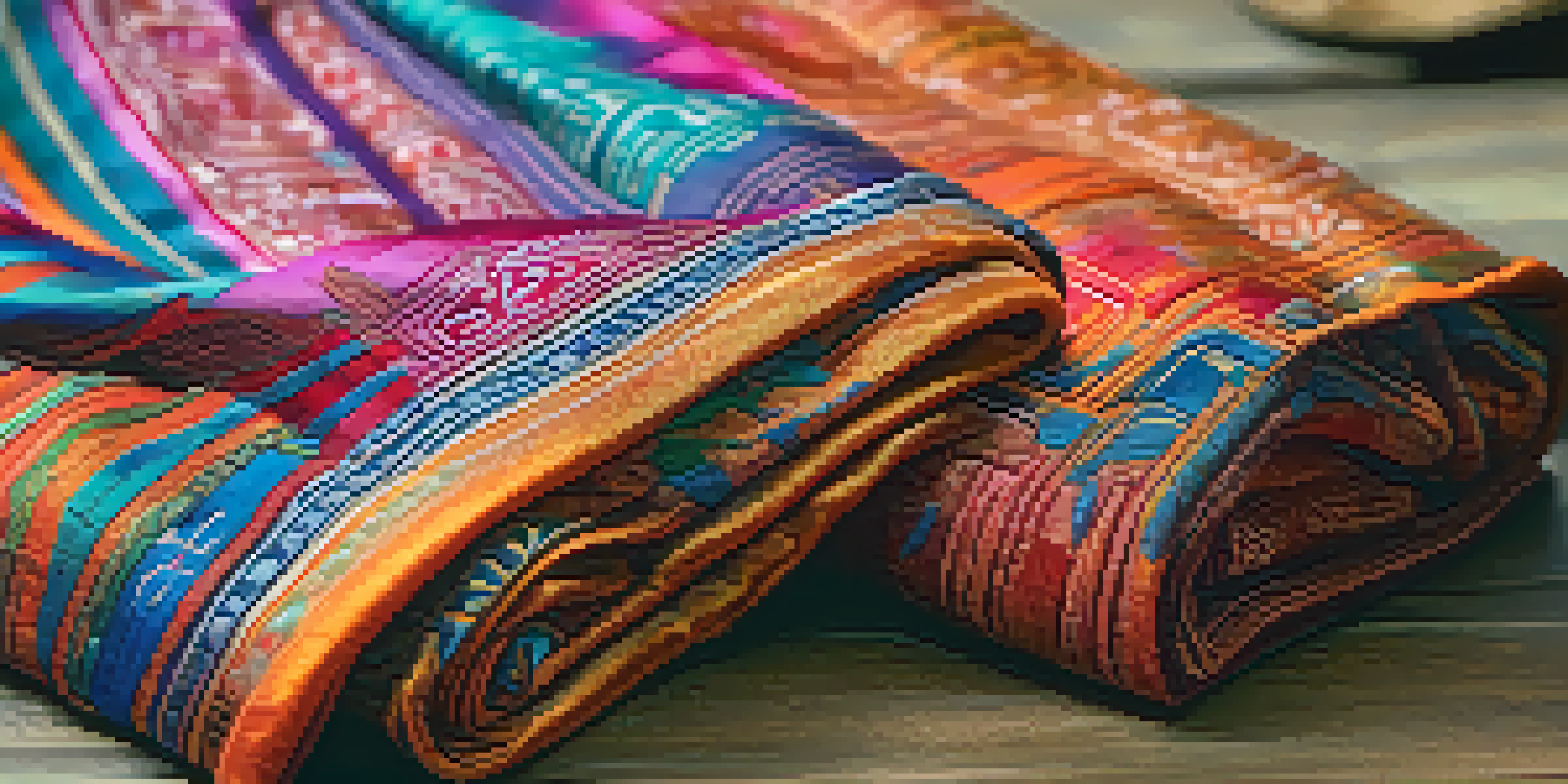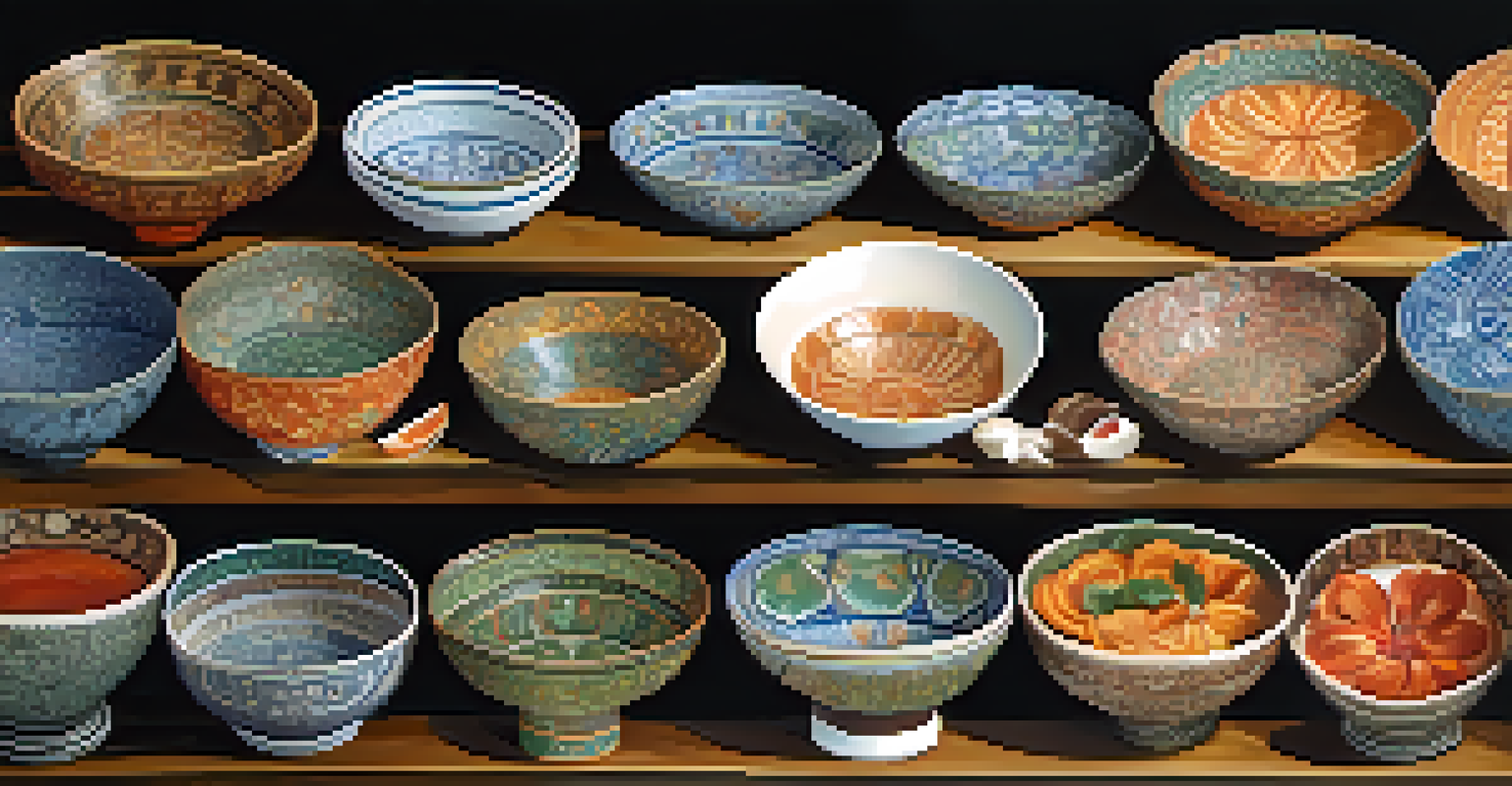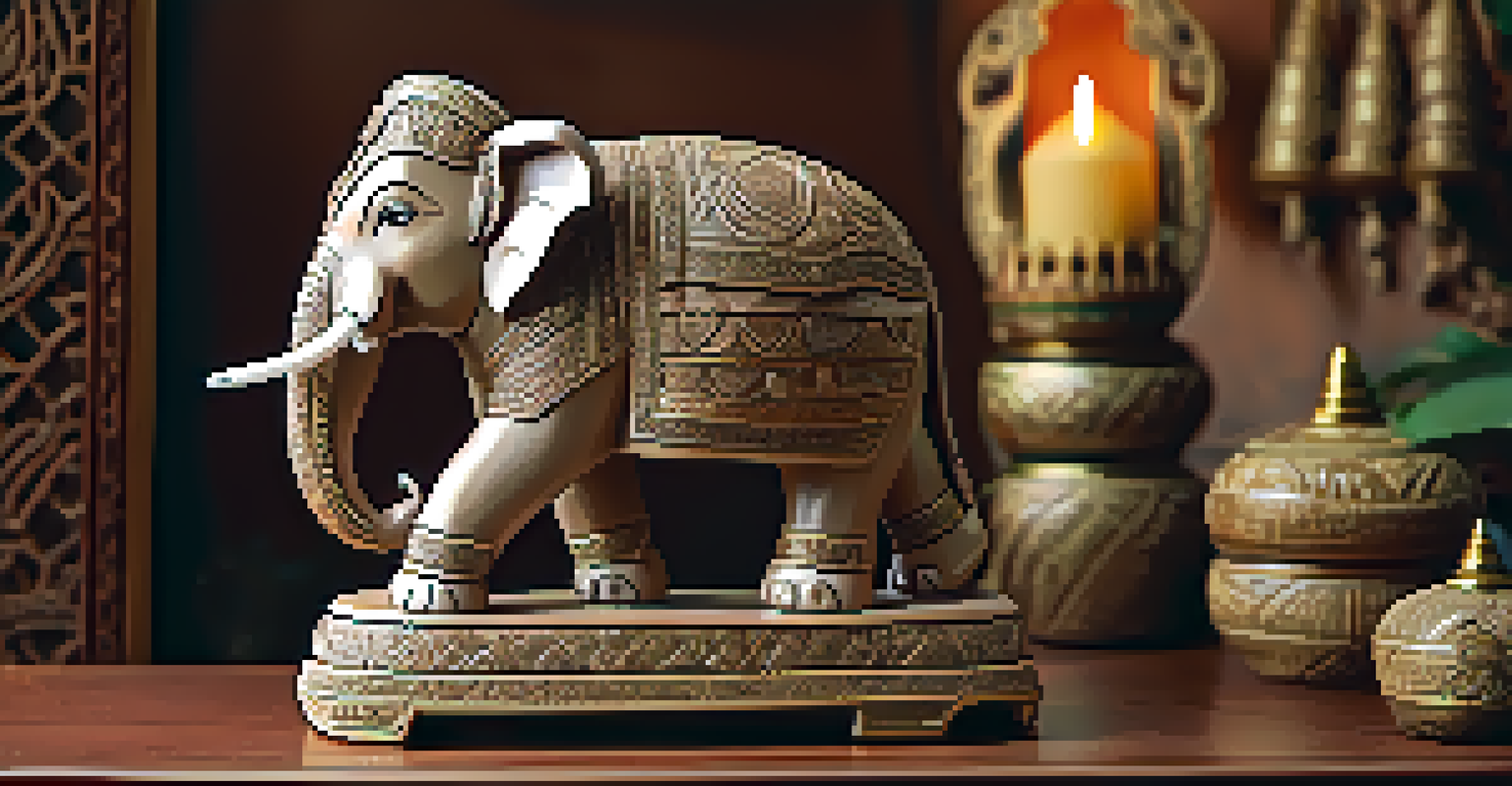Cultural Significance of Popular Thai Souvenirs

Traditional Thai Crafts: A Window to Heritage
Thai souvenirs often reflect the country's rich cultural heritage, showcasing traditional crafts that have been passed down through generations. Items like handwoven textiles, pottery, and intricate wood carvings serve as tangible connections to Thailand's artistic history. Each piece tells a story, highlighting the skills and creativity of local artisans who dedicate their lives to preserving these traditions.
Art is not a thing; it is a way.
For instance, the art of silk weaving in Thailand is not just a craft; it's a cultural legacy. The stunning silk products you see in markets represent countless hours of labor and a deep respect for the land and its resources. When you purchase a silk scarf or a piece of clothing, you're not just buying a product; you're supporting an age-old practice that embodies community and identity.
Moreover, these traditional crafts often have deep spiritual and symbolic meanings. Many souvenirs are infused with local beliefs and customs, making them significant not just as decorative items, but also as cultural symbols that resonate with the values and histories of the Thai people.
The Allure of Thai Cuisine: Edible Souvenirs
Thai cuisine is renowned worldwide, and edible souvenirs like spice mixes, sauces, and snacks are a delicious way to bring a taste of Thailand home. These culinary souvenirs often carry the flavors and aromas that define Thai cooking, allowing travelers to recreate their favorite dishes long after their trip has ended. It's like capturing a moment of your journey in a jar or a packet.

Take, for instance, the iconic chili paste known as 'Nam Prik Pao.' This savory and spicy condiment is a staple in Thai households and represents the bold flavors that Thai cuisine is famous for. When you bring home a jar, you're not just getting a condiment; you're bringing back a piece of culinary tradition that can spark memories of shared meals and experiences.
Thai Crafts Reflect Cultural Heritage
Traditional Thai crafts, like textiles and pottery, serve as tangible connections to the country's rich artistic history and local traditions.
Additionally, many of these edible souvenirs come with stories of their origins and the people who produce them. Purchasing these items supports local farmers and producers, making them not only a tasty choice but also a meaningful one. Sharing these flavors with friends and family can also serve as an introduction to Thai culture, making it a delightful conversation starter.
Buddhist Art: Spiritual Souvenirs from Thailand
Buddhism plays a significant role in Thai culture, and souvenirs such as statues, amulets, and religious artifacts reflect this spirituality. These items often serve as reminders of the teachings of Buddha and the values of mindfulness and compassion. By purchasing a Buddha statue or an amulet, travelers may find they are not only acquiring a decorative piece but also a symbol of peace and protection.
To me, the greatest pleasure of writing is not what it's about, but the music the words make.
For example, many visitors are drawn to the intricate craftsmanship of Thai Buddha statues. Each statue, from the serene expressions to the careful detailing, embodies centuries of religious devotion and artistic dedication. While these pieces can beautify a home, they also invite a sense of calm and reflection into daily life.
However, it's essential to approach these souvenirs with respect and understanding. Many locals view these items as sacred, so being mindful of their cultural significance can deepen one's appreciation for the craftsmanship and the beliefs behind them. When shared with others, these spiritual souvenirs can open up dialogues about Buddhism and the rich tapestry of Thai culture.
Colorful Thai Textiles: More Than Just Fabric
Thai textiles, known for their vibrant colors and intricate patterns, are a popular souvenir choice. Items such as sarongs, tablecloths, and bags not only showcase the artistry of Thai weaving but also tell the story of the regions they come from. Each piece often features unique designs that convey local folklore, traditions, and cultural significance.
The process of creating these textiles is steeped in tradition, often involving hand-weaving techniques that have been refined over generations. When you hold a handwoven scarf, you're experiencing a labor of love and skill that connects you to the weavers' communities. It's a wonderful way to appreciate the craftsmanship and the stories woven into each thread.
Edible Souvenirs Capture Thai Flavors
Edible souvenirs, such as spice mixes and sauces, allow travelers to recreate the bold flavors of Thai cuisine long after their visit.
Moreover, purchasing Thai textiles supports local artisans and promotes sustainable practices. Many textile producers prioritize eco-friendly methods, ensuring that their craft can be enjoyed by future generations. By choosing these items, you're not just enhancing your wardrobe or home decor; you're also contributing to the preservation of cultural heritage.
Thai Ceramics: Functional Art with Cultural Roots
Ceramics are another popular souvenir that beautifully encapsulates Thai culture. From intricately designed bowls to decorative plates, these items often feature traditional motifs that reflect local artistry. Thai ceramics can be found in a variety of styles, each with its own unique history and purpose, making them functional art that can be appreciated in everyday life.
For instance, the famous Benjarong ceramics, known for their vibrant colors and intricate designs, are not only visually stunning but also serve practical purposes. Often used for serving food or as decorative pieces, they embody a blend of beauty and functionality. When you use these ceramics at home, you're inviting a piece of Thai heritage into your life.
Additionally, many ceramic artisans infuse their work with local stories and traditions, making each piece a narrative in itself. Purchasing these items not only adds a touch of Thai elegance to your home but also helps sustain the livelihoods of local craftspeople. It's a meaningful way to cherish the cultural significance of Thailand long after your travels.
Artisan Jewelry: Personal Connections to Thai Culture
Thai artisan jewelry is a popular choice for travelers looking to take home a piece of the culture. From silver intricacies to colorful gemstone designs, these pieces often reflect the natural beauty and artistry of Thailand. Each item can be worn as a personal accessory while also serving as a conversation starter about the rich heritage behind it.
For example, silver jewelry from the northern regions, often handcrafted by local artisans, carries unique designs inspired by tribal cultures. Wearing such a piece not only adds a touch of elegance to any outfit but also connects the wearer to the stories and traditions of the artisans. It’s a beautiful way to showcase appreciation for craftsmanship and cultural identity.
Artisan Jewelry Highlights Cultural Identity
Thai artisan jewelry not only showcases exquisite craftsmanship but also connects wearers to the stories and traditions of the local artisans.
Furthermore, purchasing artisan jewelry supports local economies and encourages the continuation of traditional craftsmanship. By choosing these pieces, travelers can help sustain the livelihoods of the artisans and their families, fostering a deeper connection to Thailand's rich cultural tapestry. Each time you wear a piece of Thai jewelry, you're not just making a fashion statement; you're celebrating a culture.
Unique Thai Home Decor: Bringing Culture Home
Many travelers seek unique home decor items as souvenirs to keep the spirit of Thailand alive in their living spaces. From hand-painted lamps to intricately designed wall hangings, these decor pieces often reflect the vibrancy and beauty of Thai culture. Each item adds character to a home while serving as a reminder of cherished memories from your travels.
For instance, a hand-carved wooden elephant can serve as both a decorative piece and a symbol of good luck and prosperity in Thai culture. Such items not only enhance your home aesthetic but also tell captivating stories about the culture and craftsmanship behind them. They become focal points in your home that spark conversations and evoke nostalgia.

Moreover, by choosing unique decor items, travelers contribute to the livelihoods of local artisans and encourage the continuation of their crafts. Every piece supports the preservation of cultural heritage and promotes sustainability within the community. So, when you choose to bring a piece of Thailand into your home, you're not just decorating; you're also participating in the story of its culture.